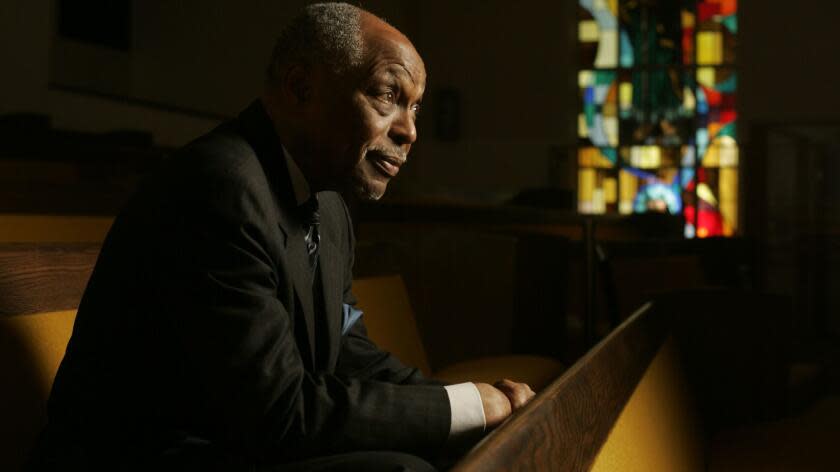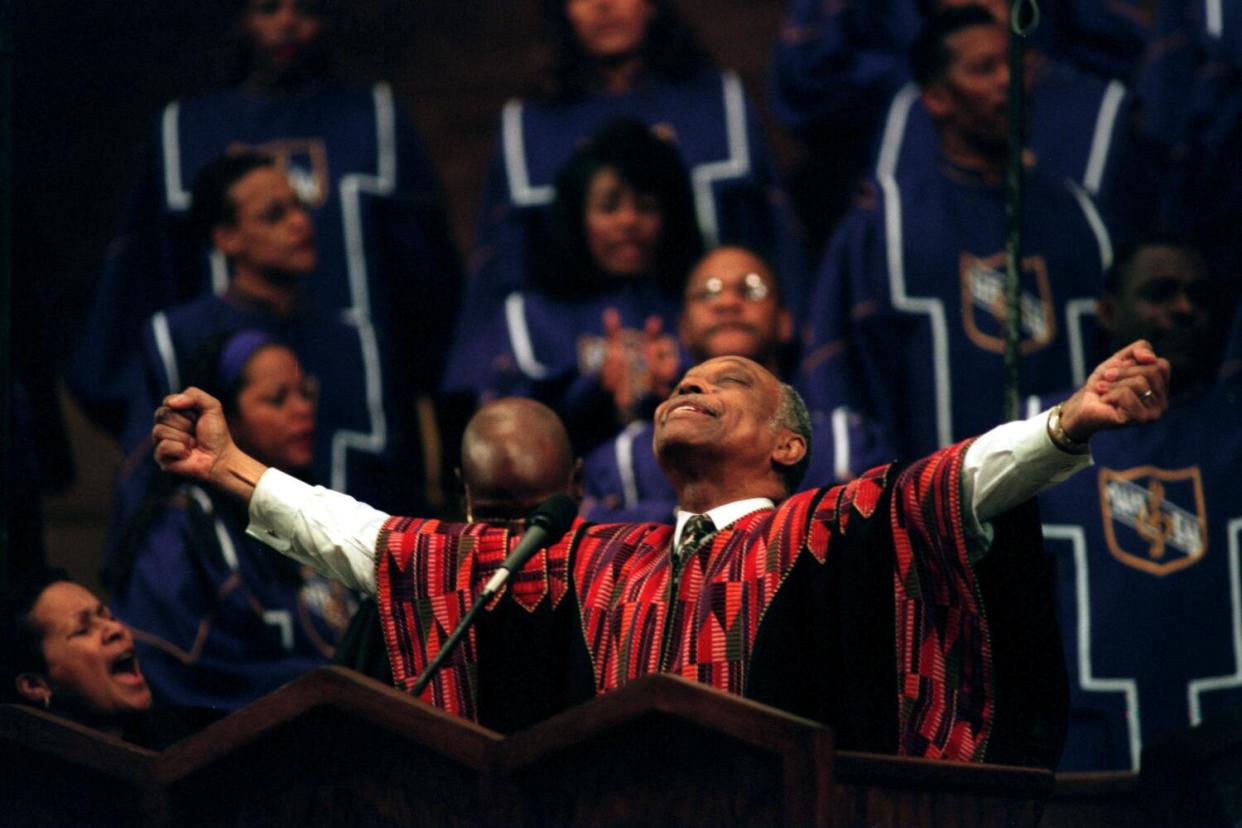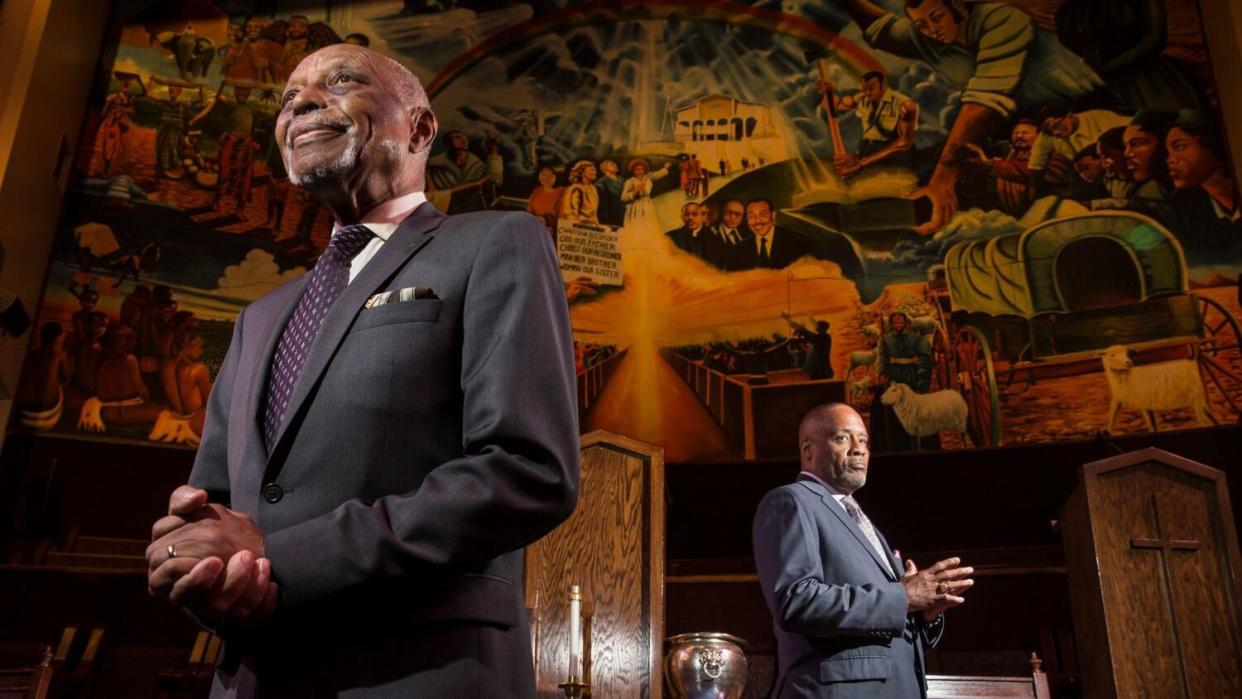Cecil 'Chip' Murray, L.A. civil rights icon and spiritual leader, dead at 94

The Rev. Dr. Cecil L. “Chip” Murray, who made the First African Methodist Episcopal Church the most prestigious Black pulpit in Los Angeles, attracting presidents, governors and mayors to hear his dynamic sermons, has died.
Murray died of natural causes Friday evening at his home in the View Park-Windsor Hills neighborhood of Los Angeles County, his son Drew Murray said. He was 94.
“He was a man who gave God his all,” he said. “He was a devoted husband, and a loving and caring father.”
Los Angeles Mayor Karen Bass issued a statement honoring Murray's legacy.
“Today we lost a giant. Reverend Dr. Cecil Murray dedicated his life to service, community, and putting God first in all things," Bass said. "I had the absolute honor of working with him, worshiping with him, and seeking his counsel. My heart is with the First AME congregation and community today as we reflect on a legacy that changed this city forever.”
During his remarkable 27-year tenure as senior minister, Murray built the First AME congregation from several hundred members to more than 18,000 worshipers whose support was often courted by elected officials and political candidates.
Presidents George W. Bush and Bill Clinton visited while Murray was in charge. California governors Pete Wilson, Gray Davis and Arnold Schwarzenegger spoke from the pulpit. Los Angeles Mayors James K. Hahn and Richard Riordan stopped by regularly, and Mayor Tom Bradley was already a member of the city's oldest Black congregation when Murray arrived.
Compassionate and charismatic, Murray emphasized taking Christian beliefs beyond the modern church building that housed his congregation, a structure that was designed by pioneering Black architect Paul R. Williams on a hill near Western Avenue and Adams Boulevard looking out at the L.A. skyline.
“On his watch, First AME became a church that went beyond the stained-glassed windows and the walls,” the late John Mack, head of the Los Angeles Urban League, said at the time of the pastor's retirement in 2004. “It became a very important religious institution meeting pressing human needs.”

Murray, Mack said, led the church in helping feed the hungry, find jobs for the jobless and help those who “didn't have money, were out of work, out of hope.”
Mack was among many prominent city leaders who worked with Murray on police brutality issues, public education, bridge-building with other communities and mayoral commissions addressing issues involving Black Americans.
Passionate about education, Murray helped the congregation start a private school, which is now named after him, and saw that thousands of students received college scholarships.
Equally determined about economic development, the pastor pushed the church to partner with government or corporate sponsors, especially after First AME became an epicenter of L.A.'s Black community — and he became internationally known — during and immediately after the 1992 Los Angeles riots.
“I saw my father on television. I heard him on the radio. So many newspapers called the house, from Philadelphia, Washington, D. C., one lady even called from Australia,” his son, Drew David Murray, recalled at the time of his father's retirement.
Murray did the “Today” show. He did “Nightline.” He talked to Time and Newsweek, to National Public Radio and to reporters from all over the world.
“The exposure, of course, brought some positive [images] about this Black church, some confirmation that the Black church in the Black community is the center of help in time of crisis and the center of change when change is needed,” Murray said in a 2004 interview with The Times. He networked with corporate CEOs and wealthy celebrities who offered help.
Among other things, Disney set aside $1 million for business loans, and former Arco chairman Lodwrick Cook kicked in half a million. Singer Barbra Streisand contributed $50,000 for food for those who had been affected by the riots. Arsenio Hall helped procure a building for housing youth activities.
“So we began to have inroads and resources, some of which have continued even to this present day,” Murray said in 2004.
The leadership at First AME also developed long-term projects to increase the economic vibrancy of the neighborhood around the church and provide access to capital for entrepreneurs who were starting or expanding businesses that provided jobs.
“One of the things that Rev. Murray is going to be most noted for — not just the baptisms, the funerals he preached and the great sermons — but the lasting institutions, all the different housing, apartments and home loans,” Bernard Kinsey, a church trustee, said while planning the minister's 75th birthday celebration. First AME is “a real diversified business of $60 million, and that just didn't happen overnight.”
For example, under the minister's leadership, First AME initiatives transformed crack houses and shabby apartment buildings into 2,000 affordable housing units for low-income families, seniors, disabled people and people with AIDS. The church also assisted thousands without homes, fed 5,000 families annually and helped hundreds of families get home loans and even purchase homes.
Jobs and training; employment assistance for ex-prisoners, welfare recipients and others down on their luck; free legal advice; AIDS programs; transportation services; adoption aid; support for foster children; emergency clothing — all this and more were available through First AME.
Its most ambitious undertaking, the FAME Renaissance Center, opened in 2001 to house the church's economic development arm, which was intended to create jobs and provide hope in a neighborhood that had been depressed by civil unrest. First AME leaders — using millions from city, state and federal sources, plus corporate contributions from Disney, State Farm Insurance and Wells Fargo Bank — transformed a 90-year-old building that had been a telephone switching station into a modern edifice containing 54,000 square feet of office and meeting space located around the corner from the church.
Bush spoke there in 2002 on the 10th anniversary of the riots, praising the church's faith-based programs as a means of helping the community in “rebuilding herself with great hope and great promise.”
Looking back a quarter of a century after the riots, Murray said the scars of the turbulence had never fully faded.
“Even today the tension is real,” he told The Times in 2017. “The police are our protectors and our defenders. But the question comes, who will protect us from our protectors? Who will defend us from our defenders?”
A fifth-generation African Methodist Episcopal, Murray often speculated that his family was related to Jane Murray, one of the worshipers who walked out of a white church in Philadelphia in 1787 during a controversy over where Black Americans would be allowed to pray. The long ago protest led to the founding of the first Black denomination in the United States, which Murray described as “the mother church of Black America.”
Murray's roots were in South Carolina, where his mother's grandparents were slaves. His father was born in 1900, just 35 years after the Civil War ended, yet he graduated from college at a time when most Southern Blacks still didn't have the opportunity to even complete grade school.
A position as a high school principal led his father to Lakeland, Fla., where Murray was born on Sept. 26, 1929, and nicknamed “Chip,” as in “chip off the old block.”
The family moved to West Palm Beach when his father became a high school principal. There, Murray got his first hint that he had been born to be a minister. When a kerosene stove caught on fire in his childhood home, his brother ran to the backyard to fetch buckets of sand to smother the flames, while he remained behind praying.
“I think I was in the third grade then. Praying, and to this day, I hear my brother say, ‘This is no time for praying. This is a time for putting out the fire.' Oh, he was a prophet, but that sensitivity to God, that sensitivity to the effects of prayer, I think that was born in me,” Murray remembered.
He served as junior pastor of his childhood church, Payne Chapel AME, leading services and giving sermons from seventh grade through his high school graduation. His yearbook predicted that one day he would be a Methodist minister in California, a prophecy that would be fulfilled years after he took a detour.
At Florida A&M University, a historic Black college in Tallahassee, he majored in history, pledged Alpha Phi Alpha, the nation's oldest Black fraternity, and worked for the school paper.
After graduation, he joined the Air Force. He trained in jet fighters and served for a decade as a radar intercept officer and then as a navigator.
In 1961, when relationships between Southern whites and Blacks were often hostile, Murray was rescued during a fiery plane crash by the plane's pilot, a white man from South Carolina. Murray would later say that his survival and the love of that pilot, who died as a result of the accident, proved to be a turning point. Believing that his life had been spared for a larger purpose, he could no longer resist the urge to minister.
With the blessing of his wife, Bernardine — the daughter, granddaughter and great-granddaughter of AME ministers — Murray decided to attend Claremont School of Theology in Southern California, where he had an uncle and a sister.
He earned a doctorate in divinity and, using his sister's dresser as the pulpit, pastored first at Primm AME church, which had only seven members and held services in a tiny building in Pomona. After a stint at Trinity AME in Kansas City, Kan., he moved on to First AME in Seattle.
In 1977, Murray took over the historic First AME church, the first Black congregation in Los Angeles. Unapologetically Black, he took down an Italian art piece portraying a white Jesus, Mary and Joseph and replaced it with a mural that showed Jesus with kinky hair and brown skin. He elevated the gospel choir from second-class status and, blessed with perfect pitch and a soothing baritone, he often joined in the singing.
With church programs, street marches and community initiatives, he reached out to Black men, who were outnumbered inside a church filled with women and at a disadvantage in a world filled with obstacles. Men, from reformed gang-bangers to multimillionaires, joined as church membership increased by thousands.
Over the years, Murray's success would invoke envy from ministers who believed he got all the news media attention and all the corporate and civic funding. More seriously, Murray was the focus of death threats.
A year after the Los Angeles riots, in 1993, a racist group plotted to assassinate him and bomb the church. However, an informant infiltrated the group and its plan was thwarted by the FBI. Several members of the group were convicted in connection with the plot.
At the sentencing, Murray agreed to talk with two of the men. At a meeting held at the Simon Wiesenthal Center, one explained his racism by telling a story of an incident that happened to him as a child. Murray told a story of his own, about how he had returned to Florida in the early 1960s after his Air Force service, expecting to be treated as a hero and, instead, white people spat on him. Then Murray and the convict wept together.
“The hardened attitudes softened,” Murray said. “I believe we understood each other.”
At the church, Murray was known as a courtly workaholic, in before dawn most days and often in his book-filled study until late at night. Of medium height and average build, he never weighed more than 10 pounds over his Air Force days. Formal in manner and dress — suit, tie, polished shoes — he demanded punctuality, preparation, attention to detail and short, to-the-point presentations from those who worked with him or wanted something from him. Some missteps would cause him to lose his temper and curse.
“The members would say my mouth needs to be baptized at times,” he joked.
More frequently, he showed a softer side — for example, when helping a suicidal homeless woman get back on track, or comforting an elderly teacher who had lost his wife earlier that day, or praying with and for others. Always praying.
“He'd work 18 hours and expect you to work 19,” Joseph D. Simmons, a member of Murray's first congregation in Pomona, said shortly before his minister's 75th birthday, the age at which AME pastors are required to retire.
In his last years in the pulpit, Murray refused to slow down.
Careful to never repeat a sermon, he continued to pack the church. In June 2004, he preached the funeral of singer Ray Charles.
And, finally, on Nov. 7, 2004, his last Sunday as senior pastor of First AME, he said goodbye to his congregation. Not with tears. Not with the word farewell, but with another reminder that to whom much is given, much is expected.
“When God has blessed you by waking you up this morning, how can you have a pity party?” he asked. Exhorting the thousands who packed the church to pray “with their feet,” he repeated a favorite challenge to go beyond the walls of the church.
Yet he watched in astonishment as some of his hard work crumbled under the leadership of his successor, the Rev. John J. Hunter, and amid allegations of financial mismanagement. Hunter was removed from the pulpit in 2012 as the church took steps to re-embrace Murray's vision.
In retirement, Murray taught at USC’s Center of Religion and Civic Culture and led a center for community engagement named in his honor. He also appeared in the award-winning 2016 miniseries “O.J.: Made in America.”
Murray is survived by his son, Drew. His wife, Bernardine, who was Murray’s high school prom date and the daughter of his childhood pastor, died in 2013.
Pollard-Terry is a former Times staff writer. Staff writer Roger Vincent contributed to this story.

This story originally appeared in Los Angeles Times.
